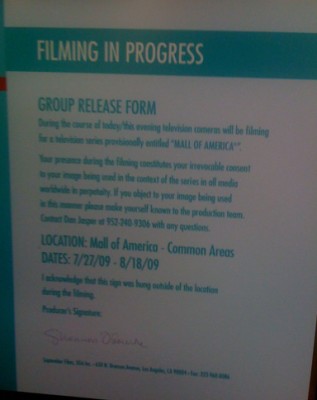When do I need a release from a person in the background of my shot?
Do I need a release or contract with every person who appears in the background of my shot?
 Suppose you're shooting a scene that takes place in a public place and you're going to have people crossing in and out of frame in the background of your shot. Do you need to get each person who does so to sign some kind of release?
Suppose you're shooting a scene that takes place in a public place and you're going to have people crossing in and out of frame in the background of your shot. Do you need to get each person who does so to sign some kind of release?
Well, in true lawyerly fashion, i'm going to answer with “It depends”.
You see, not all public places are created equal, and not all on-camera appearances are equal either…. Most filmmakers start out at either one end of the spectrum or the other.. getting releases from every single person who could possibly be seen in frame, or not bothering at all… and well, neither of those approaches is smart.
So, how diligent do you need to be?
Well, the first question you need to ask is how is this person depicted? is it a meaningful appearance, or just happenstance? Does the audience clearly see this person's face or other identifying features? Does he or she speak on camera in a way that's reasonably heard by the audience? Is there something about the appearance that would identify the person to the audience at large? If so… if the answer to any of these questions is yes, then you probably do need to get a release or waiver. If not, then you probably don't need to worry about it…. unless the footage in question is being used in a very commercial way, like as an advertisement or product promotion. The so-called Right of Publicity, which protects the right of a person to control how his or her name, likeness or persona is used, is limited, in most instances, to commercial uses. If it's a more expressive, artistic or storytelling kind of use, then it's probably going fall under the free speech/press protections of the first amendment.
Another important question that has to be considered though, is how “public” is the place where the filming occurs. If it's a publicly operated park, or an open space, where nobody reasonably expects that they're entitled to any real degree of privacy, then releases and waivers probably aren't necessary. But what if it's a pseudo-public place.. Private property that's just open to the public? For example, say you decide to shoot a scene in a shopping mall, sports arena or stadium. . These places are open to members of the public for specific purposes, but they're still (often) private property. So, when people enter these places they may have expectations that are different from when they're out in truly public spaces. So, the best practice in these situations is to either get a release.
It's also important to remember that the owners of that private property must consent to what you're doing, and THEY might require that you obtain releases or waivers.
Of course, the further toward the “private” end of the public-private spectrum a place may be, the more you'll want to err on the side of caution. If a person has a reasonable expectation of privacy, intruding into his or her space with cameras (even if through windows, or through use of telephoto lenses) is an actionable invasion of privacy.
So, what do you do when you've got footage of people for whom you think you need a waiver, but didn't get one?
Well, all is not lost. You can either track the person down for consent; blur the person's face, so he or she isn't recognizable; crop the person out of the shot, or use different footage. Obviously, you shouldn't use footage where a person has explicity asked that you not record or film them.
One technique that's used to great effect when filming in places where background action is likely to be captured is the so-called “billboard” release.. This is where the filmmakers post prominent signs at all entry points to the area where filming is to occur, stating that by entering, passersby are consenting to being filmed, photographed, recorded, and to having those images appear in any media whatsoever.
Some common approaches to crowds and groups
Generally, speaking, such releases are valid, but they're always susceptible to claims that “I didn't see any sign”. So it's important to take precautions to document the positioning of the signs, etc.
Another common approach is the so-called “on-camera” release, where the person gives a waiver orally while the camera is recording. At first blush this would seem to be quite effective, but as often as not, the on-camera waiver is incomplete or limited in some way. People (subjects and producers alike) often forget to include some of the details… name, contact details, and the precise scope of the authorized use are all necessary.
Best practice: get it in writing!
Bottom line, it's better, and often faster, to just get these things in writing. The production crew should have a bunch of blank release forms available for these situations. But don't assume that all releases are created equal. Every production is different, and template forms may not always cover the bases adequately. The last thing you need is something that actually causes more trouble than it solves. It's wise, therefore, to have an experienced entertainment lawyer draw up your releases. It needn't cost much, and it can save quite a lot of headaches and financial worry later on.

Sorry, comments are closed for this post.